ALP 7.0%
Incumbent MP
Justine Elliot, since 2004.
Geography
Far north coast of NSW. Richmond covers Tweed Heads, Byron Bay, Murwillumbah, Mullumbimby and surrounding areas. It covers the entirety of Tweed and Byron council areas, as well as northern parts of Lismore and Ballina council areas, although it does not cover the towns of Lismore or Ballina.
History
Richmond is an original federation seat, and has always covered the northeastern corner of New South Wales, although it has contracted further into that corner over the last century as other seats have been created in northeastern NSW. The seat was consistently held by conservative parties from its creation until 1990, and was gained by the Country Party early in its existence in 1922, and they held it continously for almost seventy years.
Recently it has become a much more marginal seat, although the 2007 election result pushed the seat out of the marginal category.
The seat was first won in 1901 by Protectionist Thomas Ewing, who served as a minister in the Deakin government from 1905 to 1908 before retiring in 1910. His seat was retained by Liberal candidate Walter Massy-Greene. Massy-Greene went on to serve as a minister in Billy Hughes’ Nationalist governments, but lost Richmond to Country Party candidate Roland Green in 1922. He was appointed to the Senate in 1923, and served there until his retirement in 1938. He was relegated to the backbench during the Stanley Bruce government, but returned to the ministry as part of the Lyons government in the 1930s.
Green was regularly challenged by other Country Party candidates at subsequent federal elections. While the ALP stood in Richmond in 1925, Green was reelected unopposed in 1928 and faced opposition only from another Country Party candidate in 1929. At the 1931 election Green was challenged by three other Country candidates and one independent. He was regularly challenged by Robert Gibson at every election from 1928 to 1937. Green barely held on against internal party opponents at the 1931 and 1934 elections.
In 1937, two Country Party candidates and an ALP candidate all stood against the sitting Country MP. While Green came first on primary votes, Gibson’s preferences pushed Country candidate Larry Anthony ahead of the ALP candidate, and then ALP preferences gave the seat to Anthony.
Anthony served as a minister under Robert Menzies and Arthur Fadden in 1940 and 1941 and was a senior member of the Opposition during the Curtin/Chifley Labor government. In 1949 he joined Robert Menzies’ cabinet, and served in it until his death in 1957.
The subsequent by-election saw four Country Party candidates stand, although one clearly stood out, with Anthony’s son Doug polling 49.8% of the primary vote.
The younger Anthony joined the ministry in 1964 and was groomed to be the next leader of the Country Party, and upon Jack McEwen’s retirement in 1971 he became Deputy Prime Minister. The Coalition lost power in 1972, and Anthony returned to the role of Deputy Prime Minister upon the dismissal of the Whitlam government in 1975. He served in this role throughout the Fraser government, during which time his party’s name changed first to the National Country Party and then to the National Party. Following the election of the Hawke government in 1983, Anthony retired in 1984.
The seat was retained in 1984 by Nationals state director Charles Blunt, outpolling a Liberal Party challenger and overtaking the ALP on Liberal preferences, despite Blunt having no local links with the far north of NSW. Blunt immediately moved to the shadow ministry and in 1989 managed to win a leadership challenge against Ian Sinclair. His leadership saw attempts to modernise the party and bring it closer to the Liberal Party, but Blunt’s leadership was cut short in 1990 when he lost Richmond to ALP candidate Neville Newell, who won a slim margin after a 7.1% swing. While the Nationals margin had fallen below 60% in the 1980s, this still saw a big jump in the ALP vote.
Newell held on in 1993 against a challenge from Nationals candidate Larry Anthony (son of Doug and grandson of Larry Sr) and a Liberal candidate. In 1996, Newell was defeated by the third-generation of the Anthony family. Newell went on to hold the state seat of Tweed from 1999 until his defeat in 2007.
Anthony was reelected in 1998 and 2001, although won by slim margins very different to the huge margins won by his father and grandfather. The 2004 election saw Anthony, then a junior minister in the Howard government, defeated by ALP candidate Justine Elliot, against a national swing to the Coalition in a backlash against Mark Latham’s leadership of the ALP.
Elliot gained a 7.4% swing in 2007, increasing her margin to 58.9%, which was cut to 57% in 2010. Elliot was a minister in the first term of the Labor government and then a parliamentary secretary from 2010 to 2013, and returned to the backbench in February 2013.
Candidates
- John Ordish (Christian Democratic Party)
- Kev Skinner (Independent)
- Matthew Fraser (Nationals)
- Justine Elliot (Labor)
- Dawn Walker (Greens)
- Phil Allen (Palmer United Party)
Assessment
Richmond’s 7% margin would normally be considered safe. In current circumstances, a 7% margin for a Labor seat in New South Wales will be heavily contested, but in recent times the swings against Labor have been worse in Sydney than in regional areas like those included in Richmond.
2010 result
| Candidate | Party | Votes | % | Swing |
| Justine Elliot | ALP | 31,769 | 39.19 | -4.62 |
| Alan Hunter | NAT | 17,146 | 21.21 | -15.77 |
| Joan van Lieshout | LIB | 15,424 | 19.08 | +19.08 |
| Joe Ebono | GRN | 13,056 | 16.15 | +1.22 |
| Julie Boyd | IND | 940 | 1.16 | +1.16 |
| Matthew Hartley | IND | 805 | 1.00 | +1.00 |
| Stephen Hegedus | IND | 747 | 0.92 | +0.92 |
| Nick Faulkner | IND | 536 | 0.66 | +0.66 |
| David Robinson | DEM | 502 | 0.62 | +0.62 |
2010 two-candidate-preferred result
| Candidate | Party | Votes | % | Swing |
| Justine Elliot | ALP | 46,071 | 56.99 | -1.88 |
| Alan Hunter | NAT | 34,764 | 43.01 | +1.88 |
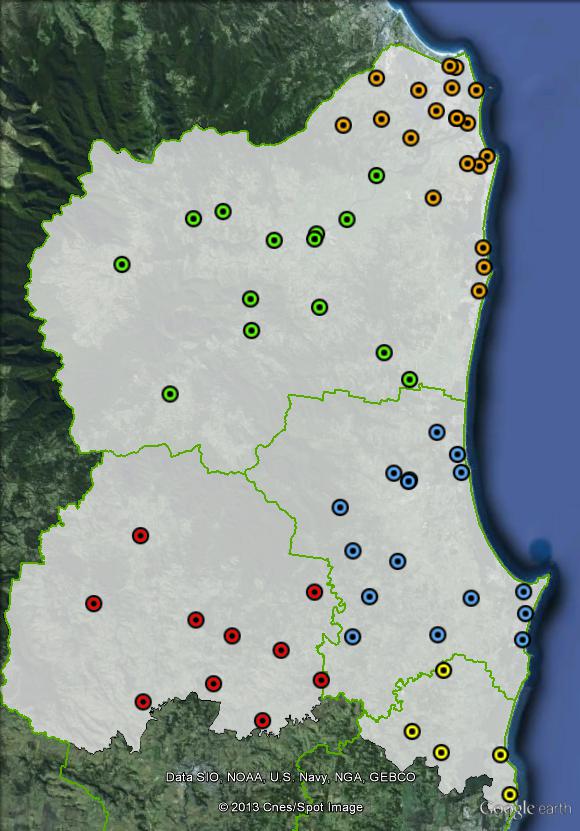
Booth breakdown
Booths have been divided into five areas, along the lines of local government areas. Polling places in Byron, Ballina and Lismore local government areas have been grouped together. Booths in Tweed, which cover a majority of the population, have been split between those in the Tweed Valley and those in Tweed Heads and on the coast.
Approximately half of all ordinary votes were cast in Tweed Heads and Coast, with substantial proportions in Byron and the Tweed Valley. Only small numbers of voters reside in the Ballina and Lismore council areas.
The ALP won a majority in all five areas, varying from 53.2% in Tweed Heads and Coast to 66.5% in Byron. The Greens vote varied from 9.4% in Tweed Heads and Coast to to 29.8% in Lismore.
| Voter group | GRN % | ALP 2PP % | Total votes | % of votes |
| Tweed Heads and Coast | 9.44 | 53.18 | 28,052 | 34.70 |
| Byron | 29.29 | 66.51 | 13,564 | 16.78 |
| Tweed Valley | 16.65 | 55.84 | 8,825 | 10.92 |
| Ballina | 15.09 | 54.25 | 4,474 | 5.53 |
| Lismore | 29.75 | 64.75 | 4,326 | 5.35 |
| Other votes | 13.92 | 55.45 | 21,594 | 26.71 |
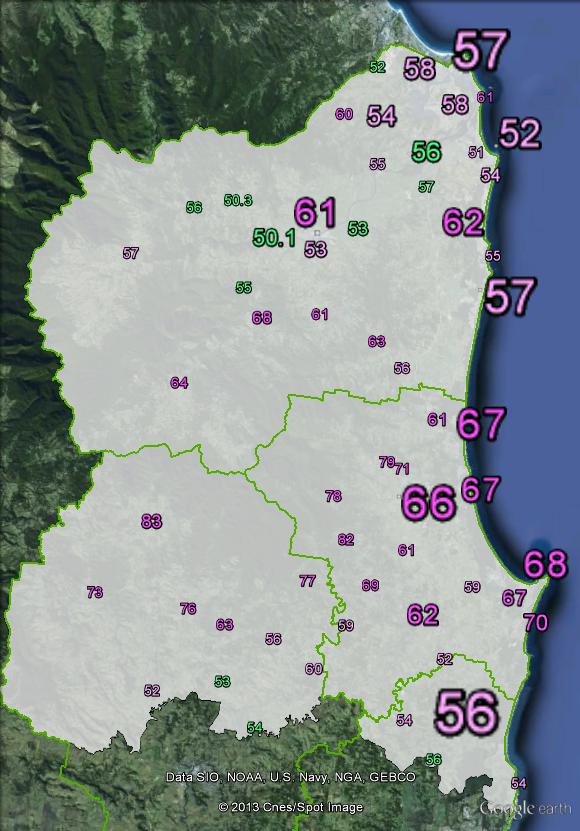
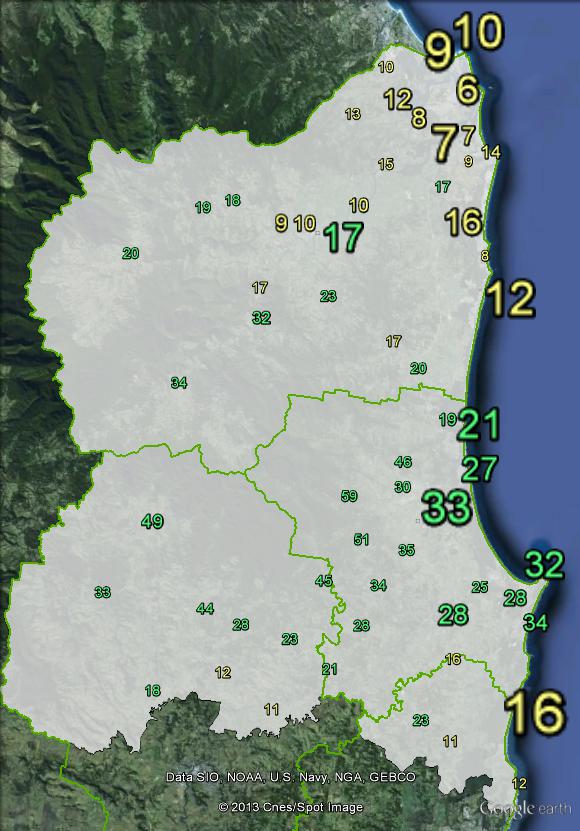
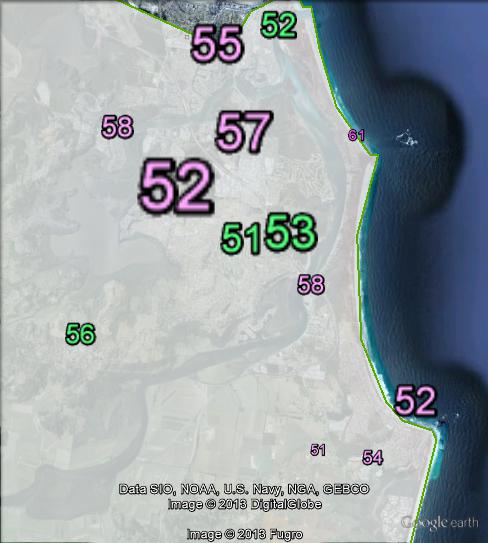
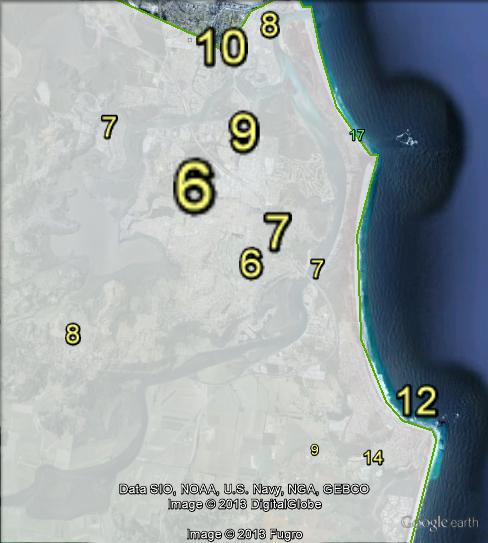


This seat will be one to watch, reason being if the Green vote takes a hit and with Labor on the nose in NSW Ms Elliot may struggle to hang on.
Chatting to people in the electorate there is a real distrust in the Labor brand and what has transpired publically.
I see a National win but this will be really close maybe not as large a swing as on the Central Coast of NSW or Western Sydney.
Ms Elliot has done a fair job in Canberra since 2007.
Plus the Liberals are not running so you can expect all that vote to go to the Nationals without a leakage of the preferences.
I’m always interested in this seat. If this falls, Page should also fall. I think there is a resonable chance the Nats can compete this time, but agree that the swing will not be as large as that around the metrolpolitan Sydney and inner regional areas within 100km of Sydney.
Alot here could depend on the number of candidates running. I tend to think if few Independents run, it will help the Nationals over Labor. I’d say this is one you could call either way. Whoever wins, the margin should be under 3%.
I think Labor are worried about this seat, especially judging by Elliot’s focus on coal seam gas, but I would tend to agree that the anti-Labor swing would not be as large in this area as in Sydney.
The Greens candidate is small business consultant Dawn Walker from Fingal Head.
Labor’s Justine Elliot, although a good member, will struggle to hold on here without a Liberal candidate. The Nationals candidate Matthew Fraser has been campaigning heavily and should be able to gain this seat back. It will however remain a marginal seat.
Looking at this seats past TPP it seems to have a very large pent up swing in it. Maybe not as much as Bathurst did but the demographics are similar. I would go against the common line of reasoning and say that at the end of the day swings in the city may be less then in regional Australia.
Viktor – I would be surprised if that were the case in NSW.
I am assuming that at the last moment Labor voters will return to the party. Since the liberal party did relatively well in Sydney do to do even better would require them to eat into the rusted on Labor section of the electorate. The voters in regional Australia have been more known to swing towards the liberals. Besides at the state level Labor does not even have a single seat in the Richmond-Page area since 2007.
The Mayor of Lismore council (which is mostly in Page) is a popular Labor woman, who won over 50% of the primary vote for that contest. It’s an interesting area politically, but there is definite progressive sentiment for the right Labor person.
Your reasoning makes sense, but every poll I’ve seen has seen Labor crashing in Western Sydney and the swing being less in Eastern Sydney, the Hunter and Illawarra and regional NSW. I suspect that both Saffin and Elliot command a strong personal vote.
It does seem like an interesting area. There may some marginal chance of Richmond holding it may not be totally lost. Page really cant see holding but hay I could be proven wrong like I was with Peter Watson since it is very hard for a non local to judge personal vote. In my defense however Peter Watson did to some extent have a sophomore surge in the areas added to Albany in 2008.
PJ – I’ve seen polls in the Hunter showing 15% swings to the Coalition. Agree on Illawarra, regional NSW and eastern Sydney. Would not surprise me to see someone like Combet or Fitzgibbon lose and Garrett win.
Phil Allen has been announced as Palmer’s candidate for Richmond. Preferences are still going to be the crucial decider in this electorate. Still think the Nationals candidate will just win though.
Elliot is likely to be promoted with Rudd as leader back to the front bench, this should also see Richmond stay in the labor collumn
Former Tweed councillor and one-time Mayor Kevin Skinner has confirmed he will nominate as an independent
http://www.mydailynews.com.au/news/skinner-surprise-past-tweed-mayor-to-contest-richm/1982236/
Skinner was a conservative-aligned councillor, so is pitching a rather curious platform. He only received 7% of the vote when elected to council in 2008, and he also indicated an interest in contesting the state seat of Tweed in 2011, which he did not proceed with.
His impact will probably be minimal, but it will be interesting to see what he does with his preferences.
Fraser seems to have been campaigning for a long time so looks to have a good operation on the ground. Inflation is probably inflated on 2010 figures due to Nat/Lib infighting, and the Nats choosing an old farmer as their candidate. Fraser is, young, energetic, with a small business background. Could be a surprise seat to watch
Always interesting to watch this seat and one that I thought would fall under Gillard. Looking more like a Labor hold now.
I live in Byron, and I think this could go to the Greens primarily because of CSG. But who knows about the rest of the electorate, we seem to live in a hippie-bubble here in Byron.
The vote shift required is too big for the Greens to win this year, but it does appear Labor is very concerned about a vote shift to the Greens particularly over CSG. Elliot has been working the strong Greens areas in the southern half of the electorate which she’s practically never visited before. She’s been at The Channon markets and was even at the Nimbin Mardi Grass back in May. Labor have also been doing a lot of polling particularly focusing on CSG in Richmond and Page. I live in Page and have been phoned twice this year by Labor pollsters – the second one was basically a push-poll on CSG. Elliot is focusing heavily on CSG and claiming a vote for her is a vote to stop CSG mining: Watch this for example:
http://www.nbnnews.com.au/index.php/2013/08/06/meet-the-candidates-vying-for-the-seat-of-richmond/
What is the TV ad ratio like, Nat to ALP?
I haven’t been watching much commercial TV, but from what i have seen there are no ads for the Richmond candidates, plenty for Kevin Hogan and some for Janelle Saffin, but none for Richmond. The national advertising is probably 50-50.